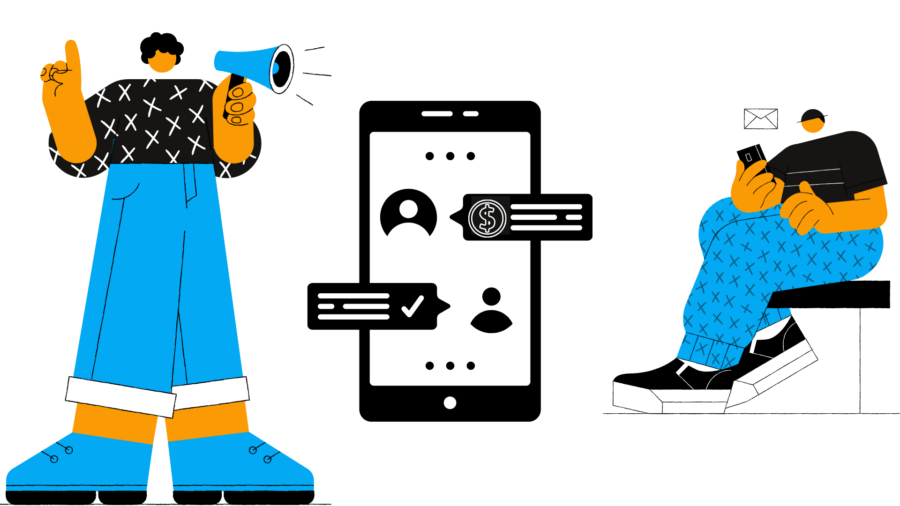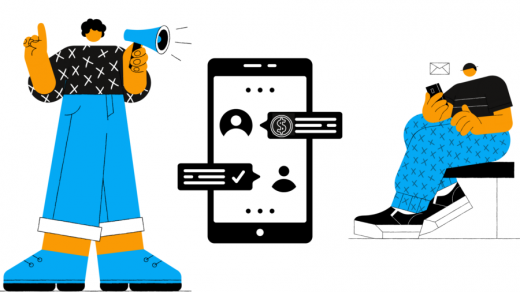Where’s Conversational Banking Headed This Year?

Banking chatbots have arrived in the finance industry – and they’re here to give banks a major boost in the form of conversational banking.
But what is conversational banking exactly and why are banking chatbots important in 2021? Come join us as we take a look.
What is Conversational Banking?
In a nutshell, conversational banking is a way of communicating with your customers via text or voice.
But here’s the crucial bit: Instead of a human operator talking to a client, it’s the job of a robot to answer their queries and nudge them in the right direction.
See, key to conversational banking are chatbots. Driven by AI and machine learning, banking chatbots are able to fulfill multiple roles that ensure the bank’s client gets what they want. For example, they can help them with loan requests, open a new account, transfer money, check balances and more.
What is the Role of Banking Chatbots?

As we’ve seen, banking chatbots are the bedrock of conversational banking. Let’s now take a look at why they’re so important in 2021.
Increased Operational Efficiency
Not all chatbots are created equal, but those that are natural language processing (NLP) based are able to contextualize information and deliver better and more appropriate responses. They can also automate tasks and fulfill customer needs day and night, and do so faster and with less friction. They’re able to answer queries and perform tasks at a speed that can even surpass that of a human.
Not just that, but chatbots lower costs by reducing the need for physical branches and call centers, thus increasing operational efficiency even more.
Improved Customer Experience
Customers in 2021 want quick solutions along with a seamless digital banking experience. COVID-19 has made customers more conscious of remote data security and they certainly expect a high degree of security for their personal finances. They don’t want to be left waiting around, which suggests that traditional methods of contacting a bank, such as telephone, are already becoming increasingly antiquated.
A chatbot is able to communicate with clients securely and get access to important information. They also work on various platforms, which gives clients the chance to use a messaging app of their choice.
Moreover, banking chatbots make it easier and faster for customers to access their bank, which in turn encourages engagement and loyalty. Chatbots also reduce waiting time and they’re “always on.” This means that a customer can contact you whenever they want and get an answer to their query.
All of this leads to an improved customer experience.
Unique Data Insights
Banks might have access to a lot of customer data – but often fail to get value out of it. Without face-to-face conversations with their clients, it can be difficult for a bank to grab key data insights about their financial lives.
This is where conversational banking comes in. Banking chatbots are able to extract and make sense of customer data, which allows them and the bank to establish more personal and meaningful relationships. Then, the bank can offer highly personalized and customized experiences and products.
Essentially, a banking chatbot can understand more about each specific customer than a human operator could ever dream of.
Popular Use Cases For Conversational Banking
Not sure how to implement conversational banking exactly? Here are a handful of ways to utilize it.
1. Help Customers Send Money
With banking chatbots, customers can easily send money to pay bills, transfer cash to friends and family, and set up new payments or cancel existing payments.
The process is super simple. The client just needs to command the chatbot what it is they want them to do, the chatbot will then clarify the command before asking for confirmation.
2. Help Customers Check Their Balances
The great thing about this is that the banking chatbot does more than just provide the customer their balance – they also offer balance estimates, as well as automated alerts that let customers know whenever they’re in danger of being overdrawn.
3. Complete Tasks Faster
Provided the issue isn’t too complex, conversational banking is able to complete specific tasks faster. For example, it can be used to unlock a card, reset a password and complete an urgent money transfer.
This is because banking chatbots are available 24/7, which itself boosts the customer experience.
4. Answer Basic Questions
Imagine if customers had to address a human operator each time they needed to ask a basic question, such as how to apply for a credit card? It would waste time and valuable resources.
Fortunately, conversational banking is able to provide basic answers to basic queries. They can also push customers in the right direction, and even put them in touch with a human operator for any complex queries.
5. Send Useful Reminders
Conversational banking is able to personalize the customer experience by sending reminders for things like payment deadlines via non-invasive push notifications. They can also update customers on any alterations to their credit scores and other important notifications.
Wrapping Up
Conversational banking is headed in one direction in 2021 – to the frontline of the way banks communicate with their clients. Banking chatbots can solve a host of customer queries, complete simple but urgent tasks for clients, and massively improve the customer experience. This in turn helps banks build better relationships with their customers.
And, the most exciting bit is that conversational banking is still in its infancy. There’s much more to come.
Business & Finance Articles on Business 2 Community
(20)


